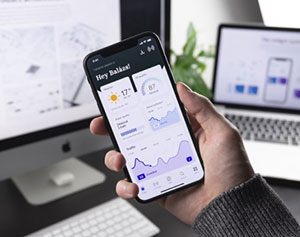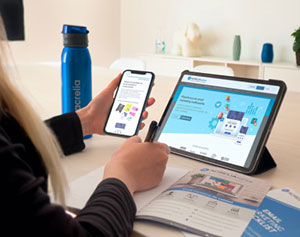Expand Your B2B Sphere of Influence—Without Putting Your Brand at Risk

Blog post By Paula Chiocchi on 2025-04-02
In the B2B world, influence is everything—and how you expand that influence is evolving fast. Traditional marketing channels aren’t as effective at breaking into new buying groups as they once were. Trust, it turns out, is the new driver behind purchase decisions.
According to Edelman, modern B2B buyers are looking to influencers, communities, and digital creators to help guide decisions “in a manner that reflects the social-first nature of modern buying groups.” That means it’s time for marketers to look beyond their owned content and customer databases and into ecosystems, partners, and voices that buyers already trust.
Done well, expanding your sphere of influence through strategic partnerships, microinfluencers, and B2B communities can help you gain visibility with high-value buyers you may never reach otherwise. However, as Forrester points out, there’s also a new risk equation to consider: brand safety.
Here are five things to keep in mind if you want to grow wisely and gain trust—without putting your brand at risk.
1. Think Bigger About Brand Safety
Most marketers think of brand safety as a placement issue—don’t let your logo, ads, or articles appear next to questionable content. Recently Forrester’s 2024 B2B Brand and Communications Survey revealed that the definition has dramatically expanded.
As many as 58% of B2B marketing leaders now say brand safety includes how they form partnerships, choose suppliers, and make business decisions—not just where their ads show up.
In other words, the company you keep—the influencers, platforms, communities, and vendors you align with—reflects on your brand. Before joining an ecosystem or launching a co-branded campaign, ask:
- Does this partner’s behavior align with our values?
- How might their reputation affect ours if something goes wrong?
- Would our customers trust this alliance?
The influence you gain by extending your reach is only powerful if it adds to your brand’s credibility. Clearly, you never want it to undermine it.
2. Leverage the Power of “Trust Transference”
Forrester calls it trust transference—the idea that buyers are more likely to trust your brand if you’re associated with a brand they already trust.
Their research found that 74% of business buyers are likely to trust a company affiliated with a trusted brand—compared to just 42% if the affiliation is with an untrusted one.
That makes partnering with well-regarded microinfluencers or niche industry groups a smart trust-building play—especially if you're trying to break into a new audience. It also means vetting your partners is non-negotiable. The same halo effect that can build trust can also burn you if a partner’s reputation falters.
3. Choose Partners That Extend Your Reach—Strategically
At OMI, we see this dynamic in action all the time. As a performance marketing agency specializing in custom audience building, here are a few ways we’ve enabled clients to build new inroads into valuable market segments without compromising their brand:
Partnering with microinfluencers in niche healthcare segments to reach decision-makers in a sensitive, highly regulated space—backed by clean, trusted audience data.
Running acquisition campaigns via co-branded emails that warm up cold contacts with trusted content first—improving response rates while keeping messaging compliant and on-brand.
Powering omni-channel campaigns that pair programmatic ads and email outreach with strategic identity-matched audiences—allowing clients to “borrow” trust from the communities their targets already belong to.
In each case, the goal was to increase visibility while staying anchored in trust, brand alignment, and data quality.
4. Prepare for the “What-Ifs”
Even with careful planning, brand risk is never zero. Forrester recommends that marketers prepare with a crisis communication plan that includes:
- Evaluating high-risk relationships ahead of time
- Aligning with legal and executive leadership on response protocols
- Being ready to act quickly to preserve trust in the event of a reputational hit
Strong brands aren’t just known for good marketing—they’re known for resilience. That means having a plan for what to do when something goes wrong, not just when everything’s going right.
5. Don’t Just Grow—Grow Wisely
The pressure to grow pipelines, reach new markets, and influence buyers is real, but as your brand’s sphere of influence expands, so does its exposure. That’s why it makes sense to take a strategic, values-first approach to partnerships, content ecosystems, and influencer programs. When done right, these alliances:
- Build trust through association
- Extend your reach to new, qualified buyers
- Create opportunities to lead, not just advertise or promote
When done wrong, they erode the very thing you're trying to build -- credibility. Expanding your B2B influence is essential—but brand safety must scale alongside it. In a world of growing interconnection, your brand is only as strong as the company it keeps.
At OMI, we give B2B brands a powerful way to build custom audiences and data-driven campaigns that boost performance without compromising reputation. Connect with our team for a conversation about how we can assist you in reaching your marketing goals: request@outwardmedia.com.
DOWNLOAD YOUR FREE ebook
At OMI, we believe good things happen when you share your knowledge. That's why we're proud to educate marketers at every level - in every size and type of organization - about the basics of email marketing and the contact data that powers it.
-
The Executive's 15-Minute Guide to Building a Successful Email Marketing Database
-
A 15-Minute Guide to Fortune 2,000 Businesses and Executives
-
Five Best Practices for Using Email Marketing to Target SMBs



